Samsung 18-200mm f/3.5-6.3 ED OIS Lens Review
Samsung 18-200mm f/3.5-6.3 ED OIS Performance
At 18mm and maximum aperture, sharpness in the centre of the frame is extremely high, although the clarity towards the edges of the frame falls behind somewhat, reaching good levels of sharpness. Stopping down improves sharpness across the frame, with peak sharpness being achieved at f/4. Here the clarity in the centre of the frame is outstanding and sharpness towards the edges of the frame is very good.Zooming to 70mm results in a disappointing reduction in sharpness across the frame at all apertures. Clarity approaches very good levels in the centre of the frame between f/8 and f/11 and sharpness towards the edges of the frame is fairly good.
Finally, at 200mm, sharpness is reduced further, with fair to fairly good sharpness at maximum aperture. Good sharpness is achieved in the centre of the frame with the lens stopped down to f/8.
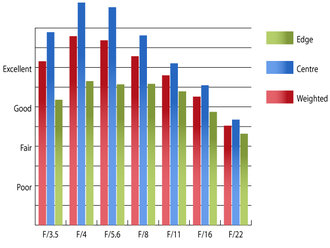 MTF@18mm | 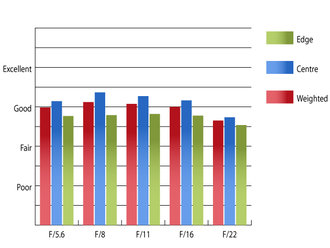 MTF@70mm |
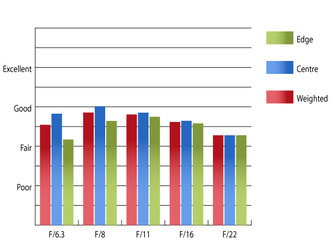 MTF@200mm | How to read our chartsThe blue column represents readings from the centre of the picture frame at the various apertures and the green is from the edges. Averaging them out gives the red weighted column.The scale on the left side is an indication of actual image resolution. The taller the column, the better the lens performance. Simple. For this review, the lens was tested on a Samsung NX20 using Imatest. |
Chromatic aberrations can be a problem with this lens, especially at 70mm, where ringing towards the edges of the frame approaches one and a half pixel widths. Care may need to be taken when shooting high contrast subjects with this lens as a result.
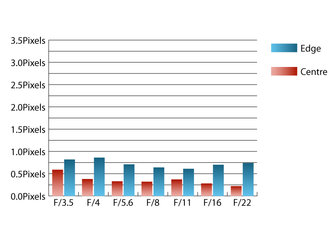 CA@18mm | 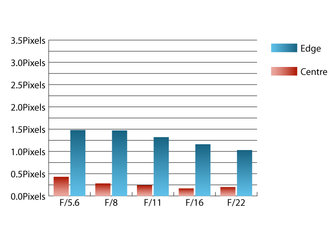 CA@70mm |
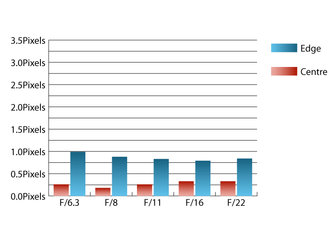 CA@200mm | How to read our chartsChromatic aberration is the lens' inability to focus on the sensor or film all colours of visible light at the same point. Severe chromatic aberration gives a noticeable fringing or a halo effect around sharp edges within the picture. It can be cured in software.Apochromatic lenses have special lens elements aspheric, extra-low dispersion etc. to minimize the problem, hence they usually cost more. For this review, the lens was tested on a Samsung NX20 using Imatest. |
Falloff of illumination towards the corners is extremely well controlled throughout the zoom range, remaining consistent with corners being 0.4 stops darker than the image centre at maximum aperture. Stopping down by one stop from maximum aperture results in visually uniform illumination.
Distortion is very well controlled, with pincushion distortion ranging between 0.0443% at 18mm and 0.565% at 200mm. These levels are so low that lines parallel to the edge of the image area can be considered straight for most purposes.
A petal-shaped lens hood is provided with this lens as standard, which does a reasonable job of shading the lens from extraneous light that may cause flare of loss of contrast. This lens can be a little prone to flare and shooting into the light can often result in reduced contrast, so it's probably best to leave the hood in place at all times.
Add your message
Login required
Please login here or if you've not registered, you can register here. Registering is safe, quick and free.
Please login here or if you've not registered, you can register here. Registering is safe, quick and free.
photodo Stats
1102 lenses
428 MTF tests
74 in-depth photodo reviews
100+ users join each day
Help the lens community by reviewing or rating a lens today via our lens search
428 MTF tests
74 in-depth photodo reviews
100+ users join each day
Help the lens community by reviewing or rating a lens today via our lens search
Latest Lens Reviews
- Chinon 28mm f/2.8 Vintage Lens Review
- Canon EF 70-200mm f/4L IS II USM Lens Review
- Samyang AF 85mm f/1.4 EF Review
- Sigma 70mm f/2.8 DG Macro Art Review
- Samyang AF 24mm f/2.8 FE Review
- Meike 50mm f/1.7 Review
- Tamron 70-210mm f/4 Di VC USD Review
- Lensbaby Burnside 35mm f/2.8 Review
- Asahi Super Takumar 50mm f/1.4 Review
- Asahi Super-Multi-Coated Takumar 135mm f/3.5 Review
